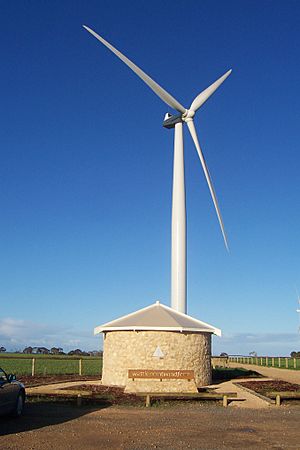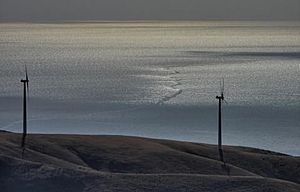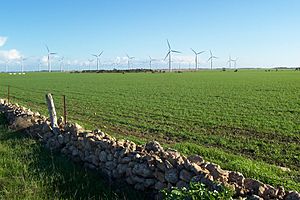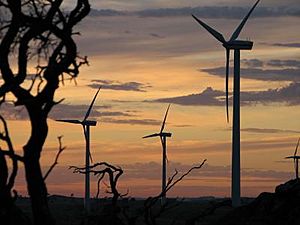Wind power in South Australia facts for kids

Wind power has become a really important way to make electricity in South Australia over the last 20 years. In 2015, wind farms could make 1,475 megawatts (MW) of power. This was about 34% of all the electricity made in the state! It also made up 35% of all the wind power in Australia. By 2021, South Australia's wind farms could make even more power, reaching 2052.95 MW. In 2020, this provided 42.1% of the state's electricity.
Many things have helped wind power grow so much in South Australia. The Australian Government has a plan called the Renewable Energy Target. This plan makes sure that electricity companies get some of their power from clean sources like wind. The South Australian Government also helps by making rules that support wind farms and giving money back on taxes for big renewable energy projects. Also, South Australia is close to the "Roaring forties" winds. These are very strong winds that are perfect for wind farms to use. In 2009, the government even started a group called RenewablesSA to encourage more clean energy projects.
Wind farms don't always run at their full power. The "load factor" (or capacity factor) for wind farms in South Australia is usually between 32% and 38%. This means that, on average over a year, a wind farm produces about 32% to 38% of the power it could make if it ran all the time.
Contents
- Wind Farms in South Australia
- Details on Operational Wind Farms
- Snowtown Wind Farm (369 MW)
- Hallett Wind Farm (350 MW)
- Hornsdale Wind Farm (315 MW)
- Lake Bonney Wind Farm (278.5 MW)
- Lincoln Gap Wind Farm (212 MW)
- Waterloo Wind Farm (131 MW)
- Willogoleche Wind Farm (119 MW)
- Wattle Point Wind Farm (91 MW)
- Mount Millar Wind Farm (70 MW)
- Cathedral Rocks Wind Farm (66 MW)
- Clements Gap Wind Farm (56 MW)
- Canunda Wind Farm (46 MW)
- Starfish Hill Wind Farm (33 MW)
- Future Wind Farm Plans
- Cancelled Wind Farm Plans
- Impacts of Wind Power
- 2011 Renewable Energy Plan
Wind Farms in South Australia
Back in 2003, South Australia only had one large wind turbine in Coober Pedy that could make 0.15 MW of power. By early 2004, the state had wind farms that could make 34 MW.
By December 2010, South Australia had 13 working wind farms, able to make 1,018 MW. By August 2014, this grew to 1,473 MW, providing 27% of the state's electricity. By late 2015, many new wind farms were being planned, and one, the Hornsdale Wind Farm, was being built.
South Australia has made it easy for wind farms to get approved. The government has good plans for where to build wind farms. In 2009, the Premier, Mike Rann, said that South Australia wanted to get 33% of its energy from renewable sources by 2020. This was much higher than the national goal of 20% by 2020.
| Total Power (MW) |
Wind Farm | Owner | Stage | Power (MW) |
Started working... |
|---|---|---|---|---|---|
| 368.7 | Snowtown wind farm | Tilt Renewables Palisade Investment Partners |
1 | 98.7 | September 2008 |
| 2 | 270 | October 2014 | |||
| 350.7 | Hallett Wind Farm | AGL Energy | 1 | 94.5 | March 2007 |
| 2 | 71.4 | September 2009 | |||
| 4 | 132.3 | August 2010 | |||
| 5 | 52.5 | July 2011 | |||
| 316.8 | Hornsdale Wind Farm | Neoen | 1 | 102.4 | June 2016 |
| 2 | 102.4 | February 2017 | |||
| 3 | 112 | August 2017 | |||
| 278.5 | Lake Bonney Wind Farm | Infigen Energy | 1 | 80.5 | March 2005 |
| 2 | 159 | April 2008 | |||
| 3 | 39 | September 2009 | |||
| 130.8 | Waterloo Wind Farm | Palisade Investment Partners Northleaf Capital |
1 | 111 | November 2010 |
| 2 | 19.8 | November 2016 | |||
| 126 | Lincoln Gap Wind Farm | Nexif Energy | 1 | 126 | April 2019 |
| 2 | 86 | ||||
| 119 | Willogoleche Wind Farm | Engie | - | 119 | August 2018 |
| 90.75 | Wattle Point Wind Farm | AGL Energy | - | 90.75 | April 2005 |
| 70 | Mount Millar Wind Farm | Meridian Energy | - | 70 | February 2006 |
| 66 | Cathedral Rocks Wind Farm | EnergyAustralia/ Acciona |
- | 66 | September 2005 |
| 56.7 | Clements Gap Wind Farm | Pacific Hydro | - | 56.7 | February 2010 |
| 46 | Canunda Wind Farm | Engie/Mitsui | - | 46 | March 2005 |
| 33 | Starfish Hill Wind Farm | RATCH-Australia | - | 33 | September 2003 |
Details on Operational Wind Farms
Snowtown Wind Farm (369 MW)
This wind farm is located near Snowtown, about 150 km north of Adelaide. The first part of the Snowtown wind farm was finished in 2008 and could make 98.7 MW. The second, larger part, which can make 270 MW, was finished in November 2014.
Hallett Wind Farm (350 MW)
The Hallett Wind Farm was built in four steps. Hallett 1 was finished in June 2008 and has 45 turbines that make 95 MW. Hallett 2 was finished in late 2009 and has 34 turbines making 71.4 MW. Hallett 4 was fully working by early 2011 with 63 turbines making 132 MW. Hallett 5 was finished in early 2012 and has 25 turbines making 52.5 MW.
Hornsdale Wind Farm (315 MW)
The Hornsdale Wind Farm was built in three stages. Stage 1 was finished in September 2017 and has 32 turbines making 102.4 MW. Stage 2 was finished in June 2017, also with 32 turbines making 102.4 MW. Stage 3 was finished in December 2017 and has 35 turbines making 112 MW.
Lake Bonney Wind Farm (278.5 MW)
The Lake Bonney Wind Farm was built in three stages. Stage 1 was finished in March 2005 and has 46 turbines making 80.5 MW. Stage 2 was finished around April 2008 and has 53 turbines making 159 MW. Stage 3 has 13 turbines making 39 MW. When all three stages were done, it was the biggest wind farm in Australia at that time.
Lincoln Gap Wind Farm (212 MW)
The Lincoln Gap Wind Farm is built on the hills near Lincoln Gap. This is a place where the main highway and railway line pass through.
Waterloo Wind Farm (131 MW)
The Waterloo Wind Farm was first built in 2010 and could make 111 MW. It cost about $300 million. It has 37 large turbines. The wind farm is about 30 km south-east of Clare and 100 km north of Adelaide. In 2016, six more turbines were added, increasing its total power to over 130 MW.
Willogoleche Wind Farm (119 MW)
The Willogoleche Wind Farm is in the Mid North area of South Australia, just west of the town of Hallett.
Wattle Point Wind Farm (91 MW)
The Wattle Point Wind Farm is near Edithburgh on the Yorke Peninsula. When it opened in June 2005, it was Australia's largest wind farm, making 91 MW. It has 55 wind turbines and cost 165 million Australian dollars to build.
Mount Millar Wind Farm (70 MW)
The Mount Millar Wind Farm is located between Cowell and Cleve, about 100 km southwest of Whyalla. Its 35 wind turbines can make up to 70 MW of electricity. It started making power in February 2006.
Cathedral Rocks Wind Farm (66 MW)
The Cathedral Rocks Wind Farm is in a remote coastal area near the southern tip of the Eyre Peninsula. It has 33 wind turbines that can make 66 MW in total. It was fully working by 2007.
Clements Gap Wind Farm (56 MW)
In February 2010, Pacific Hydro opened the 56.7 MW Clements Gap Wind Farm. It is in South Australia's mid-north. This project has 27 wind turbines that make enough electricity for 30,000 homes.
Canunda Wind Farm (46 MW)
The Canunda Wind Farm cost $92.5 million and can make 46 MW of power. It is located about 16 km south of Millicent. It has 23 wind turbines and was opened in March 2005.

Starfish Hill Wind Farm (33 MW)
The Starfish Hill Wind Farm is near Cape Jervis on the Fleurieu Peninsula. It has 22 turbines that can make 33 MW of power. It started working in September 2003, making it the first big wind farm in South Australia.
Future Wind Farm Plans
Besides the wind farms already working, South Australia has plans for new ones. Here are some of them:
| Planned Power (MW) |
Wind Farm | Location | Developer | Status | When it might start |
|---|---|---|---|---|---|
| 180 | Barn Hill | Between Snowtown and Clements Gap wind farms | AGL Energy | Approved in 2009, revised in 2013 | AGL hopes to decide by mid-2023 |
| 600 | Ceres Project | Yorke Peninsula | Spark Renewables | Approved 2014. New plan approved August 2019. New owner is preparing a new application. | Unknown |
| ? - 26 turbines | Crystal Brook energy park | Crystal Brook | Neoen | Approved August 2019 | Construction expected 12 months after approval |
| 144-250 | Exmoor | Naracoorte | Acciona | Application lodged 2011, might have expired by 2019 | 2017 |
| 412 | Goyder South Wind Farm | Southeast of Burra | Neoen | Being built now | 2024 |
| 120 | Kongorong | Kongorong (west of Mount Gambier) | RATCH-Australia | Might have expired before 2019 | Not on company website |
| 110 | Kulpara | northwest of Port Wakefield | RATCH-Australia | Might have expired before 2019 | Not on company website |
| 375 | Palmer | Palmer, Tungkillo, Sanderston | Tilt Renewables | Being looked at, approved 2015, appeals dismissed 2019 | |
| 206.5 | Port Augusta Renewable Energy Park | south of Port Augusta | DP Energy and Iberdrola | Being built now | 2022 |
| 14–200 | Tungketta Hill/Elliston | Between Elliston and Sheringa | Ausker Energies | Approved | Developer said construction would start when power line issues are fixed (last updated 2014). |
| 185 | Twin Creek Wind Farm | northeast of Kapunda | RES Australia | Approved May 2019 | |
| 350 | Woakwine | near Beachport | Infigen Energy | Approved 2012 |
Cancelled Wind Farm Plans
Myponga Wind Farm
The Myponga Wind Farm was a plan by TrustPower to build a wind farm in the southern Mount Lofty Ranges, near Myponga. It was approved in 2003 and was supposed to start working by 2010. However, the approval was cancelled in 2011. TrustPower decided not to go ahead because the government didn't approve changes to the height and type of turbines.
Keyneton
Pacific Hydro planned to build a 105 MW wind farm near Keyneton. The government approved it in 2013, but the plan was cancelled in October 2019.
Impacts of Wind Power
Having more renewable energy, like wind power, has made electricity production in South Australia much cleaner. This means less pollution from making electricity.
Building and running wind farms has also helped the economy. By October 2011, about $2.8 billion had been invested in wind power. This created around 3,000 direct and indirect jobs. Studies show that a 50 MW wind farm can pay land owners about $250,000 a year. Workers building the farm might spend up to $1.2 million in local areas, and the farm can give up to $80,000 each year to community projects.
Sometimes, people in rural areas have concerns about wind farms. They worry about how wind farms might affect property values, health, and the environment.
There has been some discussion about how wind power affects electricity prices in South Australia. Some reports suggested that electricity prices were very high in South Australia compared to other places. However, others have pointed out that wind power can actually help lower wholesale electricity prices. This happens because cheaper wind power is used before more expensive power sources. Data from the Australian Energy Market Operator (AEMO) shows that increases in prices were mainly due to higher costs for power lines and distribution networks.
The South Australian Government said that the price increase from the Australian Government's carbon price (which was in place from 2012 to 2014) was about half of what other states experienced. This was because South Australia had a lot of wind and gas-fired power.
2011 Renewable Energy Plan
In October 2011, the South Australian government released a plan for renewable energy. Here are some of the main ideas:
- To get 33% of the state's electricity from renewable sources by 2020.
- To stop new coal-fired power stations from being built.
- To let local councils have more say in approving wind farm projects, so communities are more involved.
- To look into making power lines stronger to support more wind energy.
- No wind farms allowed within one kilometer of any home, unless the developer and home owner agree.





